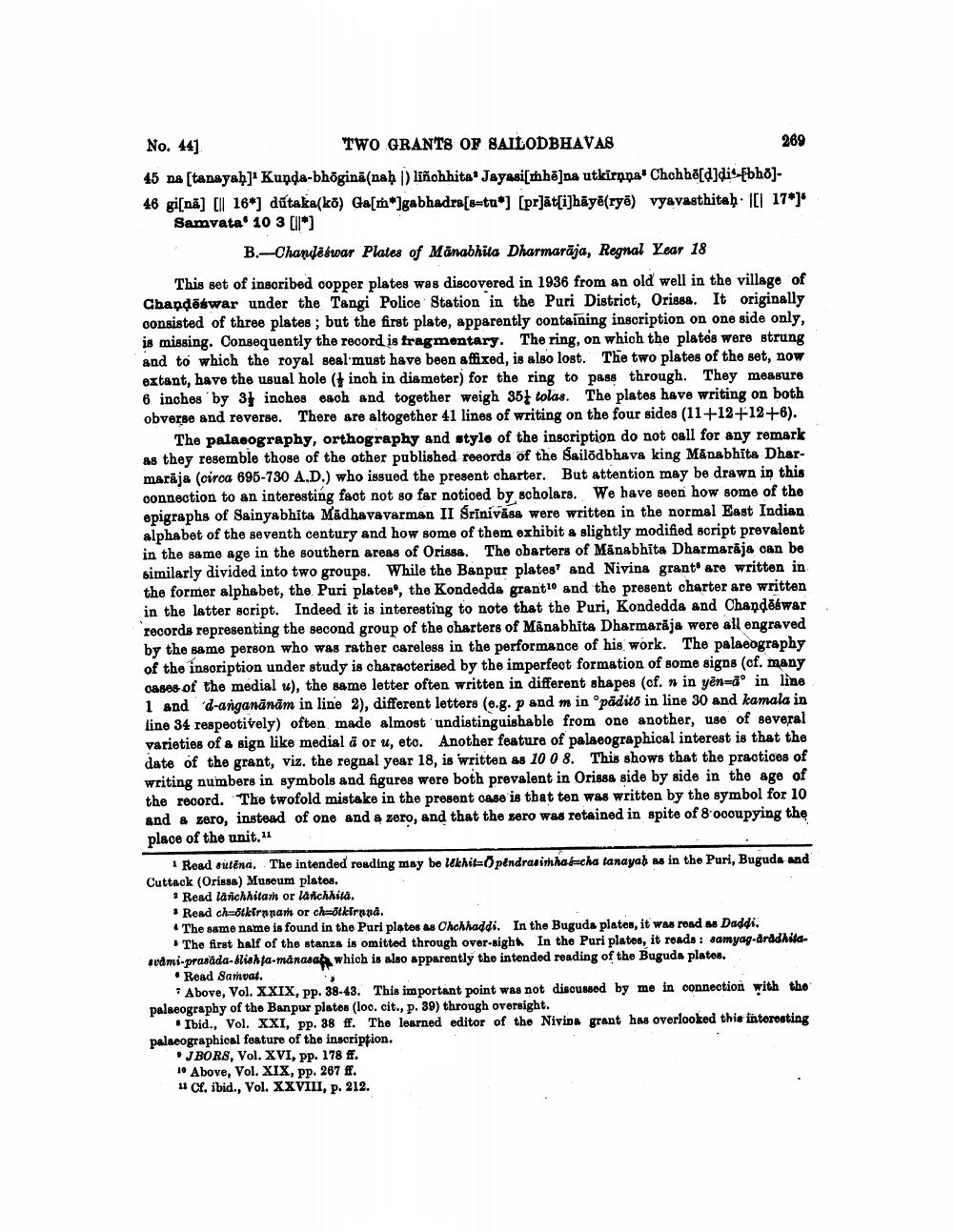________________
No. 441 TWO GRANTS OP SAILODBHAVAS
269 45 na stanayaḥ]* Kunda-bhöginä(naḥ 1) liñohhita. Jayasi[mhhö]na utkirnna' Chchhő[aldi - bho). 46 gi[nā] [ll 16*] dutaka(ko) Ga[n]gabhadra[s=tu) [pr]āt[i]hayē(ryē) vyavasthitaḥ. 101 17*]" Samvata 10 3 [l*)
B.-Chandëswar Plates of Mänabhita Dharmarāja, Regnal Year 18
This set of inscribed copper plates was discovered in 1936 from an old well in the village of Chandēswar under the Tangi Police Station in the Puri District, Orissa. It originally oonsisted of three plates; but the first plate, apparently containing inscription on one side only, is missing. Consequently the record is fragmentary. The ring, on which the plates were strung and to which the royal seal must have been affixed, is also lost. The two plates of the set, now extant, have the usual hole ( inch in diameter) for the ring to pass through. They measure 6 inches by 34 inches each and together weigh 357 tolas. The plates have writing on both obverse and reverse. There are altogether 41 lines of writing on the four sides (11+12+12+6).
The palacography, orthography and style of the inscription do not call for any remark as they resemble those of the other published records of the Sailodbhava king Månabhīts Dharmarāja (circa 695-730 A.D.) who issued the present charter. But attention may be drawn in this connection to an interesting fact not so far noticed by scholars. We have seen how some of the epigraphs of Sainyabhita Madhavavarman II Srinivasa were written in the normal East Indian alphabet of the seventh century and how some of them exhibit a slightly modified script prevalent in the same age in the southern areas of Orissa. The obarters of Mānabhita Dharmarājs can be similarly divided into two groups. While the Banpur plates? and Nivina grant are written in the former alphabet, the Puri plates', the Kondedda grant and the present charter are written in the latter script. Indeed it is interesting to note that the Puri, Kondedda and Chandēswar records representing the second group of the charters of Mānabhita Dharmarāja were all engraved by the same person who was rather careless in the performance of his work. The palaeography of the inscription under study is characterised by the imperfect formation of some signs (cf. many cases of the medial w), the same letter often written in different shapes (cf. in yên-do in line 1 and 'd-anganänām in lino 2), different letters (e.g. p and m in opädito in line 30 and kamala in line 34 respectively) often made almost 'undistinguishable from one another, use of several varieties of a sign like medial å or u, eto. Another feature of palaeographical interest is that the date of the grant, viz. the regnal year 18, is written as 10 0 8. This shows that the practices of writing numbers in symbols and figures were both prevalent in Orissa side by side in the age of the record. The twofold mistake in the present case is that ten was written by the symbol for 10 and a zero, instead of one and a zero, and that the zero was retained in spite of 8 oooupying the place of the unit. 11
1 Read sutēna. The intended reading may be likhitopendrasimhacha tanayak as in the Puri, Buguda and Cuttack (Orissa) Museum plates.
* Read lanchhitath or lanchhita. • Read chrotkiraram or chatkirana. • The same name is found in the Puri plates as Chchhaddi. In the Buguda plates, it was road as Daddi.
. The first half of the stanza is omitted through over-sight. In the Puri plates, it reads: samyag-arddhitasedmi-prasāda-flishta-manasan which is also apparently the intended reading of the Buguda plates.
• Read Sarvat.
. Above, Vol. XXIX, pp. 38-43. This important point was not discussed by me in connection with the palaeography of the Banpur plates (loc. cit., p. 39) through oversight.
. Ibid., Vol. XXI, pp. 38 ff. The learned editor of the Nivina grant has overlooked this interesting palaeographical feature of the inscription.
. J BORS, Vol. XVI, pp. 178 ff. 1. Above, Vol. XIX, pp. 267 ff. 11. Cf. ibid., Vol. XXVIII, p. 212.




